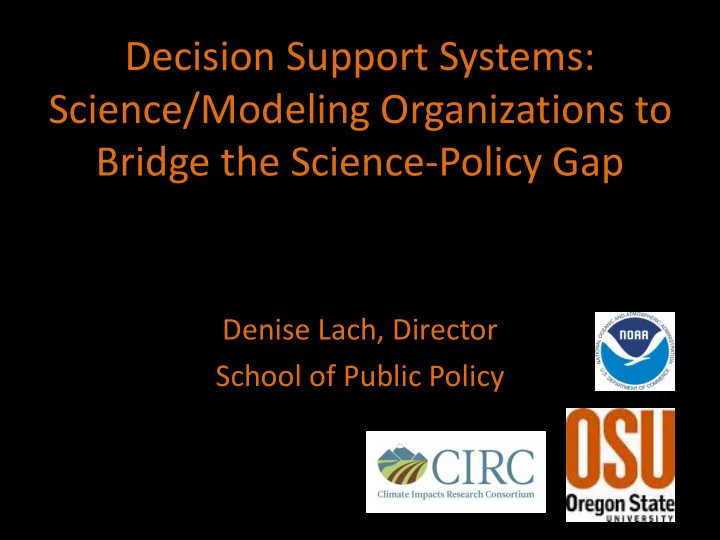

Decision Support Systems: Science/Modeling Organizations to Bridge the Science-Policy Gap Denise Lach, Director School of Public Policy
Wicked Problems • Solution depends on how problem is framed • Stakeholders have radically different world views for understanding the problem • Problem constraints and resources needed change over time • Problem is never solved definitively
Super Wicked Problems • Time is running out • No central authority • Those seeking to solve the problem are also causing it • Policies discount the future non-rationally
Complications: Uncertain Futures
Role of Science in Wicked Problems
High Decision Stakes High Low System Uncertainties
High Decision Stakes Normal Science High Low System Uncertainties
High Professional Decision Consultancy Stakes Normal Science High Low System Uncertainties
High Post-Normal Science Professional Decision Consultancy Stakes Normal Science High Low System Uncertainties
Post-Normal Science • Facts are uncertain, values in dispute, stakes high, and decisions urgent • Less than desired information available • Not all factors are necessarily knowable • Always faced with uncertainties • Mistakes can be costly or lethal
Coping with Wicked Problems • Authority • Competition • Collaboration
Can we substitute process for certainty in resolving wicked problems?
Post-normal Boundary Organizations for Integrating Science and Policy Produce useable knowledge about climate impacts in the PNW Design decision Form a support tools to Assemble research translate the needed agenda around research expertise to the needs of answers into address key stakeholders practical questions applications
Some Recent PNW Study Areas Skagit 2060 Kitsap Futures Willamette Water 2100 Treasure Valley Big Wood Basin Tillamook Coastal Futures Forest People Fire
Envision – Conceptual Structure Landscape Performance Models Landscape Generating Landscape Metrics Reflecting Feedbacks “Stuff People Care About”, e.g. Water Scarcity, Habitat, Jobs Multiagent Decision Visualizations Models Stakeholder Actors selecting Landscape Engagement and policies and Temporal GIS Understanding generate land management decision affecting Dynamic Maps, landscape pattern Charts, Flyovers/ Flythroughs … Policies and Landscape Process Models Scenarios Biophysical/Social/Economic Models (e.g. (From Stakeholder Climate, Hydrology, Population Growth, Veg Process) Dynamics, Fire, …)
Scenario Planning Identify System, Process Develop Initial Datasets Develop Implement System Plan Models Scientists Stakeholders Develop Create Preferred Scenarios Scenario Evaluate Scenarios
Endpoints as Starting Points for fModeling
Alternative Scenarios: Economic base, management approach Highly Highly Highly Managed Managed / Managed / Agricultural Tourism Economy Economy Management Less Less Less Managed Managed / Managed / Agricultural Tourism Economy Economy Ag Economy Tourism Economy Economic Base
Big Wood Climate Model Selection
12 Alternative Scenarios: economic base, management approach, climate scenario
ENVISION Model Framework
Thinking About Complicated Information: What’s Important?
Types of Information from Model: High Elevation April 1 SWE 1980-2009 Interquartile Range 2 out of 3 modeled simulations indicate a consistent reduction in April 1 SWE.
Types of Information from Model: SWE
Types of Information: Frost Free Periods
Big Wood Data Atlas
Lessons Learned: Modeling Challenges Data Computation Availability Level of Detail Stakeholder Uncertainty Relevance It’s a Balancing Act! Empirical Mechanism Basis (Processes)
Lessons Learned: Project Design • Projects are both challenging and interesting • Integration should come first, not last • Systems approach essential – we need more systems thinkers • Multidisciplinary approach is critical • Place Matters – be clear about what is general and what is specific
Lessons Learned: Collaboration • Team dynamics determines success or failure • The “Culture of Science” can be a plus and a minus - + Solid scientific footing to be useful, credible – “ Out of box” thinking critical – disciplinary boundaries can limit thinking • Stakeholders are generally pretty interesting people who know a heck of a lot – engage the thought leaders early and often
Lessons Learned: Communicating Usable Knowledge • Make assumptions, choices transparent • Address important issues/questions • Create simple visuals • Provide options for individual exploration • Develop intuitive interface – stories? • Provide meta data and data access
Questions?
“Standard” Envision Plug -ins Plug-in Function Target models growth of a surface based on total and available capacities and existing densities – very useful for population growth and spatial allocation models Modeler a high-level, XML-based model specification and execution tool for relatively simple models Spatial Allocator Allows definition of global allocations, constraints and preferences, useful for a broad variety of applications, eg. Fire spread, insect infestation, crop rotations, management choices Sync a tool for synchronizing changes to related columns Trigger a tool for triggering a set of outcomes when a specified field change – similar to Sync, but more flexible, slightly slower Flow a hydrological modeling framework SppHabMatrix A flexible Habitat Suitability modeling framework Developer A tool for specifying urbanization dynamics, can be used in conjunction with Target for modeling population growth and develop processes
Envision “Adapter” Plug -ins Plug-in Function VDDT/ Dynamic vegetation models (state-transition) for DynamicVeg running VDDT-based vegetation models FlamMap Detailed Process-based fire model MAPPS Global biogeography model Geospatial Data Dynamic spatial data object for reading a variety Reader geospatial formats e.g. NetCDF MC2 Global biogeochemistry model Century V5 Biogeochemistry model
Envision Central Oregon Data Sources Evaluative Models Parcels (IDU’s) Biofuel Production Policy Set(s) Carbon Agent Descriptors Social Networks Forest Products Extraction ENVISION Autonomous Process Fire Risk (Habitat) Models Habitat Suitability Population Growth and Residential Expansion Terrestrial Biodiversity VDDT Vegetative Succession Landscape Amenities (Spatialized and Climatized) Fire Risk (Structures) FLAMMAP Fire Spread Resource Lands Protection Climate Change
Integrated Decision Units (IDUs) A spatial geometry to model both human decisions and successional processes Each IDU described in GIS by a set of attributes used to model climate effects, succession, wildfire and decisions
Recommend
More recommend